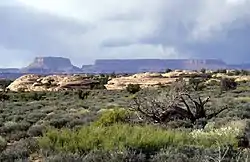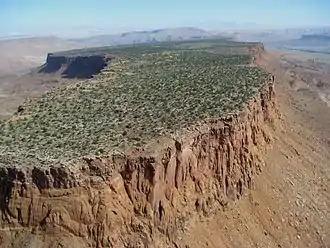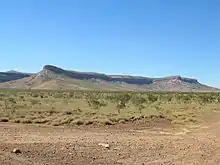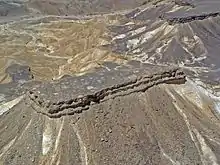Mesa
A mesa is an isolated, flat-topped elevation, ridge or hill, which is bounded from all sides by steep escarpments and stands distinctly above a surrounding plain. Mesas characteristically consist of flat-lying soft sedimentary rocks capped by a more resistant layer or layers of harder rock, e.g. shales overlain by sandstones. The resistant layer acts as a caprock that forms the flat summit of a mesa. The caprock can consist of either sedimentary rocks such as sandstone and limestone; dissected lava flows; or a deeply eroded duricrust. Unlike plateau, whose usage does not imply horizontal layers of bedrock, e.g. Tibetan Plateau, the term mesa applies exclusively to the landforms built of flat-lying strata. Instead, flat-topped plateaus are specifically known as tablelands.[1][2][3]


As noted by Bryan[4] in 1922, mesas …stand distinctly above the surrounding country, as a table stands above the floor upon which it rests. It is from this appearance the term mesa was adopted from a Spanish word meaning table.[2]
A mesa is similar to, but has a more extensive summit area than, a butte. However, there is no agreed size limit that separates mesas from either buttes or plateaus. For example, the flat-topped mountains, which are known as mesas, in the Cockburn Range of North-Western Australia have areas as much as 350 kilometres (220 mi). In contrast, flat topped hills, which are as small as 0.1 kilometres (0.062 mi) in area, in the Elbsandsteingebirge, Germany, are described as mesas.[1][2][3]

Less strictly, a very broad, flat-topped, usually isolated hill or mountain of moderate height bounded on at least one side by a steep cliff or slope and representing an erosion remnant also have been called mesas.[3]
In the English language geomorphic and geologic literature, other terms for mesa have also been used.[1] For example, in the Roraima region of Venezuela, the traditional name, tepui, from the local Pomón language, and the term table mountains have been used to describe local flat-topped mountains.[5][6] Similar landforms in Southern Australia are known as tablehills, table-top hills or tent hills.[7] The German term Tafelberg has also been used in the English scientific literature in the past.[8]
Formation

Mesas form by weathering and erosion of horizontally layered rocks that have been uplifted by tectonic activity. Variations in the ability of different types of rock to resist weathering and erosion cause the weaker types of rocks to be eroded away, leaving the more resistant types of rocks topographically higher than their surroundings.[9] This process is called differential erosion. The most resistant rock types include sandstone, conglomerate, quartzite, basalt, chert, limestone, lava flows and sills.[9] Lava flows and sills, in particular, are very resistant to weathering and erosion, and often form the flat top, or caprock, of a mesa. The less resistant rock layers are mainly made up of shale, a softer rock that weathers and erodes more easily.[9]
The differences in strength of various rock layers is what gives mesas their distinctive shape. Less resistant rocks are eroded away on the surface into valleys, where they collect water drainage from the surrounding area, while the more resistant layers are left standing out.[9] A large area of very resistant rock, such as a sill may shield the layers below it from erosion while the softer rock surrounding it is eroded into valleys, thus forming a caprock.
Differences in rock type also reflect on the sides of a mesa, as instead of smooth slopes, the sides are broken into a staircase pattern called "cliff-and-bench topography".[9] The more resistant layers form the cliffs, or stairsteps, while the less resistant layers form gentle slopes, or benches, between the cliffs. Cliffs retreat and are eventually cut off from the main cliff, or plateau, by basal sapping. When the cliff edge does not retreat uniformly, but instead is indented by headward eroding streams, a section can be cut off from the main cliff, forming a mesa.[9]
Basal sapping occurs as water flowing around the rock layers of the mesa erodes the underlying soft shale layers, either as surface runoff from the mesa top or from groundwater moving through permeable overlying layers, which leads to slumping and flowage of the shale.[10] As the underlying shale erodes away, it can no longer support the overlying cliff layers, which collapse and retreat. When the caprock has caved away to the point where only a little remains, it is known as a butte.
On Mars

A transitional zone on Mars, known as the fretted terrain, lies between highly cratered highlands and less cratered lowlands. The younger lowland exhibits steep walled mesas and knobs. The mesa and knobs are separated by flat lying lowlands. They are thought to form from ice-facilitated mass wasting processes from ground or atmospheric sources. The mesas and knobs decrease in size with increasing distance from the highland escarpment. The relief of the mesas range from nearly 2 km to 100 m depending on the distance they are from the escarpment.[11]
See also
- Amba
- Archipelago – A group of islands
- Butte – Isolated hill with steep, often vertical sides and a small, relatively flat top
- Dissected plateau – Plateau area that has been severely eroded so that the relief is sharp
- Mensa (geology)
- Mesa Verde National Park – U.S. national park in Colorado
- Nor'Wester Mountains
- Potrero (landform) – A long mesa that at one end slopes upward to higher terrain.
- Table (landform) – Raised landforms that have a flat top
- Table Mountain – A flat-topped mountain overlooking the city of Cape Town
- Tepui – A table-top mountain or mesa in the Guiana Highlands of South America
- Tundra – Biome where plant growth is hindered by cold temperatures
- Tuya – A flat-topped, steep-sided volcano formed when lava erupts through a thick glacier or ice sheet
References
| Wikimedia Commons has media related to Mesas. |
| Look up mesa in Wiktionary, the free dictionary. |
- Duszyński, F., Migoń, P. and Strzelecki, M.C., 2019. Escarpment retreat in sedimentary tablelands and cuesta landscapes–Landforms, mechanisms and patterns. Earth-Science Reviews,' no. 102890. doi.org/10.1016/j.earscirev.2019.102890
- Migoń, P., 2004a. Mesa. In: Goudie, A.S. (Ed.), Encyclopedia of Geomorphology. Routledge, London, pp. 668. ISBN 9780415272988
- Neuendorf, Klaus K.E. Mehl, James P., Jr. Jackson, Julia A.. (2011). Glossary of Geology (5th Edition). American Geosciences Institute. ISBN 9781680151787
- Bryan, K., 1922. Erosion and sedimentation in the Papago Country, Arizona. US Geol. Survey Bull. 730, 19–90.
- Briceño, H.O. and Schubert, C., 1990. Geomorphology of the Gran Sabana, Guayana Shield, southeastern Venezuela. Geomorphology, 3(2), pp.125-141.
- Doerr, S.H., 1999. Karst-like landforms and hydrology in quartzites of the Venezuelan Guyana shield: Pseudokarst or" real" karst?. Zeitschrift fur Geomorphologie, 43(1), pp.1-17.
- Jack, R.L., 1915. The Geology and prospects of the Region to the South of the Musgrave Ranges, and the Geology of the Western Portion of the Great Australian Artesian Basin. Geol. Survey South Australia Bulletin 5, pp. 72.
- King, L.C., 1942. South African Scenery. A Textbook of Geomorphology. Oliver and Boyd, Edinburgh, London (340 pp.).
- Easterbrook, Don J. (1999). Surface Processes and Landforms. Upper Saddle River, NJ: Prentice Hall. ISBN 9780138609580.
- Choreley, Richard J.; Stanley A. Schumm; David E. Sugden (1985). Geomorphology. New York: Methuen.
- Baker, David M. Morphological Analyses of Mesas and Knobs in the Northwest Fretted Terrain of Mars; Constraints on the Presence and Distribution of Ice-Facilitated Mass-Wasting. Ed. Alexander K. Stewart and James W. Head. Vol. 40. Issue 2. pp. 72. United States: Geological Society of America (GSA) : Boulder, CO, United States, 2008.